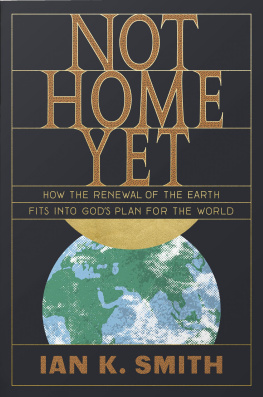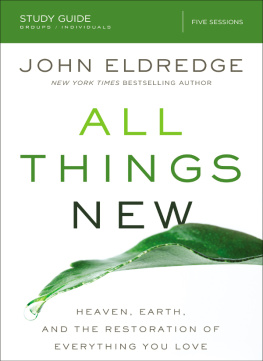Table of Contents
Landmarks
One of our challenges in reading the New Testament is knowing what has preceded it. We may know some Old Testament stories about Noah, Abraham, Moses, and David, but when we come to the second half of the Old Testament, our familiarity starts to wane. Prophets proclaim judgment. There is an exile to Babylon and a return to Judea. What has this got to do with the New Testament? The answer is, much more than we may have at first appreciated.
Return from Exile
As soon as we open the New Testament, we note that Gods people are coming home from exile. Matthews Gospel begins with a genealogy that is divided into three neat sections, each consisting of fourteen generations: from Abraham to David, from David to the Babylonian deportation, and from this deportation to Christ (Matt. 1:117). Why is the Babylonian exile given such prominence?
In the Old Testament there are three major exiles: from the garden of Eden, from Egypt, and to Babylon. The return from these exiles helps us to understand the ministry of Jesus . The exodus from Egypt is celebrated annually in the Passover festival, when Jewish people remember their salvation from the tenth plague during which the blood of a lamb was placed on the door lintels of Jewish homes in Egypt and how the angel of death passed over those houses. The Passover meal retells the story through cups of wine. During one such meal, Jesus takes one of these cups and says, This cup that is poured out for you is the new covenant in my blood (Luke 22:20). A new Israel now has a new covenant, which is established by a new defining story: a new exodus sealed by the blood of the Messiah. Jesus will bring the people of God home from the Babylonian exile.
This raises an obvious question. Hadnt the Israelites already returned from the Babylonian exile over five hundred years before Jesus s birth? The answer depends on what we are asking. If we are asking whether they were back in the land, the answer is clearly yes. If we are asking whether God had returned to dwell with his people in the land, we get a different answer. After the Babylonian exile, the temple was rebuilt, but there is no record of the Lord filling this rebuilt temple, as had been the case with the first temple (1 Kings 8:1013; 2 Chron. 5:136:2). If God did not live in his earthly home, were they truly home? Jeremiah had foretold that the return from the Babylonian exile would mark the beginning of a new Israel in a way similar to how the return from the Egyptian exile had established the old Israel. He prophesied:
Therefore, behold, the days are coming, declares the Lord , when they shall no longer say, As the Lord lives who brought up the people of Israel out of the land of Egypt, but As the L ord lives who brought up and led the offspring of the house of Israel out of the north country and out of all the countries where he had driven them. Then they shall dwell in their own land. (Jer. 23:78 )
This return from exile happens in the ministry of Jesus .
Matthew continues the theme of return from the Babylonian exile, after the opening genealogy. Similarities are drawn between Moses and Joshua, who led the Israelites home from Egypt, and Jesus , who leads his people home from Babylon. An angel appears to Joseph and tells him to name Marys son Jesus , the Greek form of the Hebrew name Joshua. Joseph, Mary, and Jesus flee from Herods pogrom in Bethlehem to Egypt, and on their return Matthew cites, Out of Egypt I called my son (Matt. 2:15; cf. Hos. 11:1). Jesus reenters the land of Judea by crossing the Jordan in his baptism (Matt. 3:1316), which reminds us of how his namesake also crossed the same river (Josh. 3:17). Jesus is declared to be Gods Son (Matt. 3:17), as was Israel (Ex. 4:22). Jesus does not succumb to temptation when he is tempted in the wilderness for forty days (Matt. 4:111), unlike Israel, whose disobedience for forty days led to forty years of wilderness wanderings (Num. 14:3334). Israel was given the law at Mount Sinai (Ex. 20:117); Jesus teaches even greater obedience to this law in the sermon on another mount (Matthew 57). Jesus is the new and greater Moses (Deut. 18:1518), who brings his people back from the Babylonian exile in an even greater way than Moses and Joshua brought the people back from the Egyptian exile.
An appreciation of the theological and historical contexts of this return from the Babylonian exile will help us to better understand Jesus s ministry. We will begin by looking at the theological context in this chapter, and in the next chapter we will address the historical context. This theological context is found in the major prophets of the Old Testament. We now turn our attention to three of these: Isaiah, Jeremiah, and Ezekiel.
Isaiah
Isaiah lived in the eighth century BC, prior to the exile. The book that bears his name begins in Jerusalem, where the prophet is given a message of doom and destruction. He receives this message through one of the most majestic pictures of God dwelling in the temple. Whereas earlier descriptions of the temple were of perceptible realitiesacacia wood, precious metals, and courtsin Isaiah 6:14, Isaiah sees the imperceptible realities within the court of heaven. Six -w inged seraphs hover above the divine throne crying, Holy, holy, holy (Isa. 6:3), as Isaiah is given a message of coming exile and subsequent return. He is also told that his proclamation will fall on deaf ears! God instructs Isaiah to say to the people:
Keep on hearing, but do not understand;
keep on seeing, but do not perceive.
Make the heart of this people dull,
and their ears heavy,
and blind their eyes;
lest they see with their eyes,
and hear with their ears,
and understand with their hearts,
and turn and be healed. (Isa. 6:910 )
This would not be easy! The message of exile and return is described in agricultural terminology of uprooting and replanting:
Then I said, How long, O L ord ?
And he said:
Until cities lie waste
without inhabitant,
and houses without people,
and the land is a desolate waste,
and the L ord removes people far away,
and the forsaken places are many in the midst of the land.
And though a tenth remain in it,
it will be burned again,
like a terebinth or an oak,
whose stump remains
when it is felled.
The holy seed is its stump. (Isa. 6:1113 )
Isaiahs commission helps us to see how Jesus s ministry is presented as a return from exile. Jesus told several parables about planting seeds, but the best known is about a sower who sowed seed on four different kinds of soil: a path, rocky soil, thorny soil, and good soil (Matt. 13:39; Mark 4:19; Luke 8:48). In the context of Isaiahs prophecy, Jesus was talking about replanting after the uprooting of the exile. This is confirmed as Jesus quotes Isaiah: To you has been given the secret of the kingdom of God, but for those outside everything is in parables, so that they may indeed see but not perceive, and may indeed hear but not understand, lest they should turn and be forgiven (Mark 4:1012; cf. Matt 13:1116; Luke 8:10; see Isa. 6:910). These verses have baffled many readers. Is Jesus deliberately confounding his listeners by telling parables? Is he concerned that if they understood, they might turn and be forgiven? Jesus then goes on to say, Do you not understand this parable? How then will you understand all the parables? (Mark 4:13). All becomes clear when we realize that Jesus is quoting Isaiah 6. He is giving a commentary on the return from exile, foretold by Isaiah, that is now happening through his ministry. God is replanting Israel in a new way, through Jesus s ministry. But not everyone accepts this. Some are like a path, others like rocky or thorny soil. But some, likened to good soil, understand what is happening. If you dont understand this, you wont understand any of Jesus s parables.













